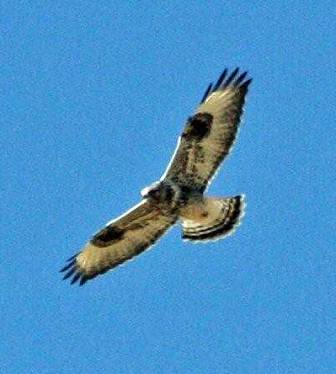[Originally appeared in the Siera Wave newsletter, Vol. 26, No. 4, Mar-Apr 2008 – click here for original with photos]

Rough-legged Hawk, Photo by Debby Parker
Bald Eagles are on everyones Wish List and they seldom disappoint. Most arrive in early November and have been seen through April, although they are not easily found after mid March. Most records are 1-2 birds but often 3-4 are seen. Seventeen were reported on the Eastern Sierra January 2008 Eagle Survey, the same number as last year but a different combination of adults and immatures (8 adults and 9 juveniles versus 11 adults and 6 juveniles in January 2007).
The Rough-legged Hawk is an enigma. In the 1970s it was often seen in numbers greater than Red-tailed Hawks, sometimes 8-10 birds in a day. In the last two decades 1-2 birds are usually reported the entire winter although when scarce in the Eastern Sierra there are reports of many more in the Bridgeport and north areas. This past December on the Bishop Christmas Count, 2-3 were seen. One party (Kristie Nelson) saw an adult male and the other party (Jon Dunn and Debbie House) had an adult male and juvenile. It is problematic if the parties saw the same adult male since the two locations are somewhat near each otherthen again, they could have been different birds.
Northern Shrikes are rarely reported November through February and all but one record are of single birds; the exception is two birds at different locations, but within flying distance, that may have been one bird moving around. This year one was reported at Big Pine in late December impaling a goldfinch (Earl & Eliot Gann).
The second group of wintering birds is normally seen in the nearby mountains during the year but some winters they can be found on or near the valley floor. Examples are jays, nuthatches, rosy-finches, and chickadees. This has been an excellent winter for some of these lowland invaders, especially Mountain Chickadees, with fewer reports of Stellers and Western Scrub-Jays. Nuthatch and rosy-finch reports have been few but one deep snowfall could change that! It is easy to assume that these species have descended from our nearby Sierra Nevada but that may not be the case since these species are found well north into Canada and are known to leave their homeland if there is a food supply failure. Some years the chickadees or jays at your feeder may be from British Columbia, not the Sierra!
Every winter also provides surprises, this year a Short-eared Owl in Deep Springs Valley (Chris McCreedy). Again, it is not known from where this bird came. Is it a resident from the marshes at Deep Springs Lake, or a visitor from the north, or an early migrant?
We are mindful that the more we learn about the birds of the Eastern Sierra the more we are aware of how much more we dont know. Winter isnt over, ornithologically speaking, until the end of February so there is time for more birds to appear providing more opportunities to discover just how much more there is to learn about winter birds in the Eastern Sierra.
As the radius of knowledge extends, the circumference of ignorance expands. [Attributed as a Japanese saying]
Tags: finch, hawk, owl, swan
